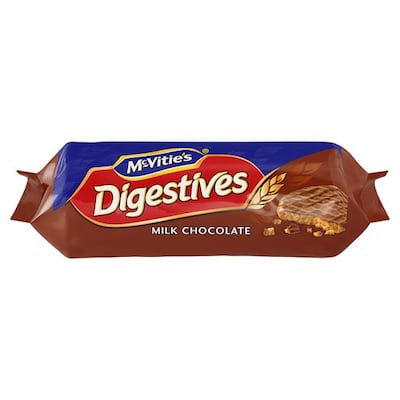There was a time when I saw chocolate digestives as the healthy biscuitty option. No pillowy pink confections or exotic coconutty treats could tempt me. With their wholegrains, fibre and probably calcium in the chocolate, there was no competition.
In my defence, I was a teenager and there was more than a grain of truth in that theory.
The range of digestive biscuits has grown, as has the list of ingredients even on McVitie’s Milk Chocolate digestives. On the positive side, there is wholemeal wheat flour in the mix. Wholemeal flour is made by milling the whole kernel of wheat to create the flour. That includes the germ, bran and endosperm so it is nutritious and high in fibre, but more difficult for bakers to work with than white flour, which includes just the endosperm.

In this packet, wholemeal flour makes up just 9 per cent of the ingredients, whereas regular white flour makes up 39 per cent. As mentioned previously, white flour has calcium, iron, niacin and thiamin added to it as so much nutrition has been knocked out during processing into flour. So these biscuits are not the wholegrain treat you might have expected, though they can be considered a source of fibre as they have 3g in each 100g.
The second ingredient on the list is milk chocolate at 30 per cent. Its ingredients are then listed as: sugar, cocoa butter, cocoa mass, dried skimmed milk, dried whey (milk), butter oil (milk), vegetable fats (sal and/or shea, palm), emulsifiers (soya lecithin, E476) and natural flavouring. Those first three ingredients are fairly standard in a bar of chocolate, but it is hard to see why they add skimmed milk, whey, butter oil and more oil in the form of vegetable fats.
Whey is a protein seen as the liquid left behind after milk has been turned into cheese. It is a boon to the food ingredients industry as it used to be seen as a waste product that needed to be disposed of. Now companies such as Glanbia sell it on for use in the food or the nutrition industry where it appears in shakes and bars.
Butter oil is a highly concentrated form of the fat made from butter or cream. Vegetable fats include sal, which comes mainly from India and is from the seed of the sal tree. It is increasingly being used as a replacement for cocoa butter.
Shea comes from the nut of the shea tree, generally from Africa. It’s often used as a skin moisturiser.
Palm fat
There is palm fat, which is common in processed food as it gives a high yield for a low cost. It is almost half saturated fat, but the real cost here is environmental, as vast tracts of land have been cleared over the years to make way for oil palm trees. I could see no indication on this package or other similar ones that the biscuit companies are using sustainable palm oil. Those that do will usually mention it on the packet, or display the Rainforest Alliance mark, which is a green frog inside a circle.
These biscuits also have plenty of sugar, as you might expect, and glucose-fructose syrup, which is essentially another form of sugar that can also add texture.
Under the heading of emulsifiers, you will find soya lecithin, which is a common ingredient in chocolate that can help to prevent that white bloom and extend shelf life. It is marked in bold as it is one of the top allergens.
The other emulsifier, E476, is polyglycerol polyricinoleates, which are used to help chocolate flow more smoothly and to reduce the amount of cocoa butter needed. Thus helping to keep costs down.
The last ingredient in the chocolate mix is “natural flavouring”, which is a wide and vague term that does not have to be explained further. This is what the Food Safety Authority of Ireland has to say in its explanatory note: “The term ‘natural flavouring’ may only be used if the flavouring component is derived from different source materials and where a reference to the source materials would not reflect their flavour or taste.” So we are left in the dark on that aspect of milk chocolate digestives.
Most chocolate digestives, such as the supermarket own brand products, have similar ingredients to McVitie’s.
These digestives score well on fibre and calorie count for a chocolately treat if you have just one or two, but that list of ingredients is off-putting.
FOOD LABELS SERIES
1) Being a successful shopper
2) Bread
3) Milk
4) Cereal
5) Rashers
6) Yoghurt
7) Soup
8) Hummus
9) Pasta sauce
10) Chinese ready meals
11) Frozen chips
12) Chilled fish
13) Egg
14) Chicken Kiev
15) Crisps
16) Mayonnaise
17) Baked beans
18) Tomato ketchup
19) Chocolate digestive biscuits











